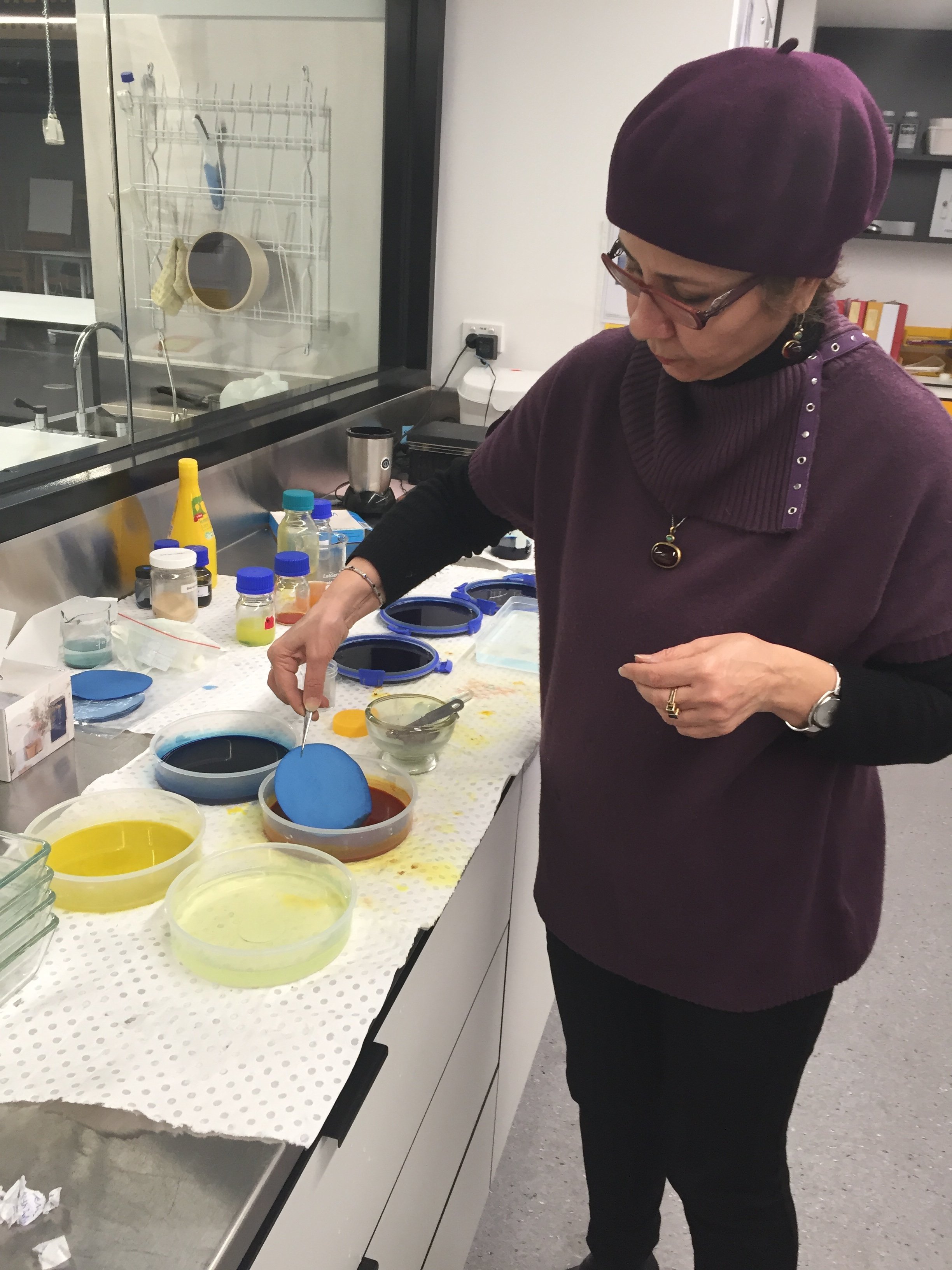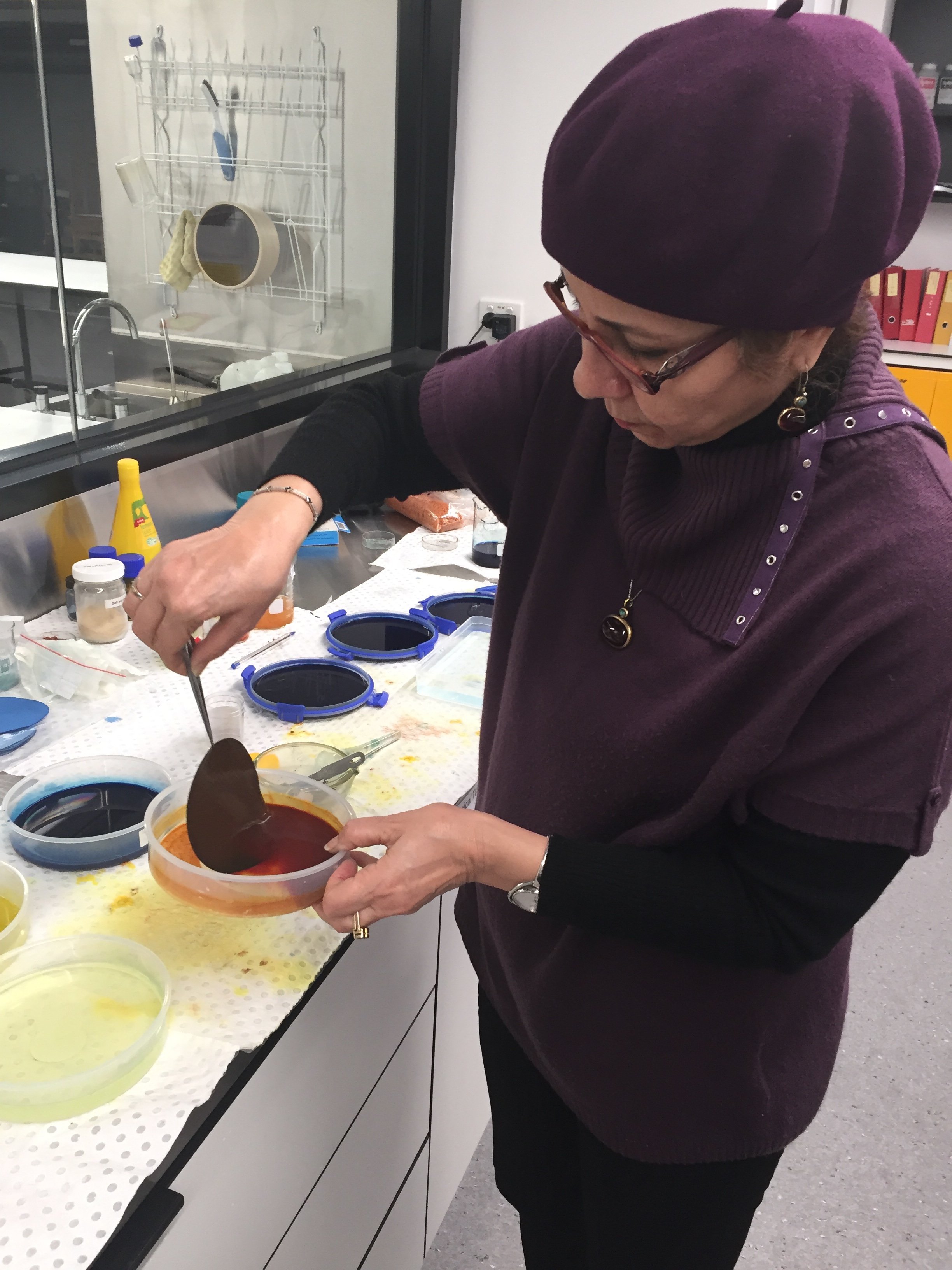MALACHITE GREEN (MARMARĪ)
The manufacture of a green color, which resembles the color of malachite, is explained in two different techniques and in three sources.
First Technique:
In two sources Resaleh Khoshnevisi (1120 A.H./1708 A.D.), and Resāleh Dar Bayān-e Rang Kardan-e Kāğaḏ (19th century) describe the first technique of making malachite green dye (marmarī) using a blue indigo paper dipped in yellow dye from bastard teak or Bengal kino (butea frondosa, Butea monosperma) known as gol-e balas in Persian mixed with alkali followed by acid bath:
یک آسار گل بلاس پاک کرده با پنج آسار آب در دیگ که چرب نباشد کرده، طبخ بدهد و بدر آورده پاره ای مالش داده، بعد از ساعتی در لتٌه صاف کند و قدری اشخار بر او زده، به دست بپالاید و کاغذی که نیل او بیشترکی باشد و تیره بود، در آب بلاس کشیده، در آب لیمو بیندازند، و از آنجا به آب صاف شسته در سایه خشک نماید، مرمری اعلا خواهد بود
Take one asar (approximately 20 grams) of gol-e balas flowers. Boil it with five asars (approximately 100 grams) of water in a grease-free large pot. After boiling, remove and mash the flowers for some time, then strain the mixture through a fine cloth. Add a small amount of alkaline ash (ašhḵār), rub it with your fingers, and add water to achieve a smooth solution. Dip paper, which has already been dyed with deep indigo, into this solution. After the dyeing process, immerse it in lemon juice. Finally, wash the paper with water and let it dry in the shade. This process will result in a good green malachite marmarī color on the paper.
Second Technique:
Another yellow colorant flower described as the second technique is a native type of yellow colorant flower from larkspur (delphinium semibarbatum) LC, mentioned in Persian historical recipes as gol-e zabān dar qafā. In Morakkab Sāzi va Jeld Sāzi (19th century), Ali Hosseini advises dipping paper in gol-e zabān dar qafā, followed by dipping it in alkali sodium carbonate to obtain marmarī. Finally, dipping it in alum (zāj-e sefid) will result in a blue shade of color.
گلِ زبان در قفا را در آبِ گرم ریزند و یک ساعت گذاشته صاف نمایند و کاغذ را دو ساعت در رنگ خوابانند و بعد از آن در آب قلیاب کشند مرمری شود و اگر به آب زاج سفید کشند آبی شود
Take some yellow larkspur (gol-e zabān dar qafā) flowers. Soak them in warm water for one hour and then strain to obtain a smooth solution. Dip the paper in this dye and let it sit for two hours. Afterward, immerse it in an alkali solution (qalyāb) [1]. This process will result in marmarī paper. If the dyed paper is dipped in alum (zāj-e sefid), it will turn blue.
[1] qalyāb: alkaline ash from impure sodium or potassium carbonate obtained from burning plant of ashnān known as ashkhār for the use in soap and glass making.
Experiment - First Technique:
The process is followed like extracting red safflower. Take 20 grams of gol-e balas flowers. Boil it with 100 ml. of water in a large pot. After boiling, remove and the flowers and make a paste. Add 1. gram alkaline ash poweder and rub it with your fingers, and add water to achieve a smooth solution. Dip paper, which has already been dyed with deep indigo, into this dye. After the dyeing process, dip it in lemon juice. Finally, wash the paper with water and let it dry in the shade.
Experiment - Second Technique:
Take 5 grams of gol-e zabān dar qafā flowers. Soak them in warm water for one hour, then strain to obtain a smooth solution. Dip the paper in this dye and let it sit for two hours. Afterward, prepare a 2-gram alkaline ash solution. Wet the dyed paper with the alkaline ash solution. Take it out and let it dry in the shade. This process will result in marmarī green paper.







